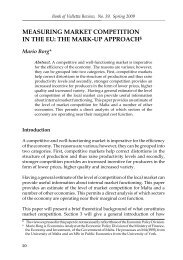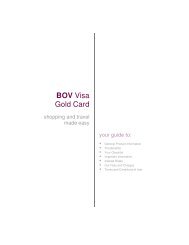Market Gaps on Access to Finance - Bank of Valletta
Market Gaps on Access to Finance - Bank of Valletta
Market Gaps on Access to Finance - Bank of Valletta
You also want an ePaper? Increase the reach of your titles
YUMPU automatically turns print PDFs into web optimized ePapers that Google loves.
Malta Business Bureau – <str<strong>on</strong>g>Market</str<strong>on</strong>g> gaps in access <strong>to</strong> finance<br />
April 2013<br />
3.5 Financing instruments for SMEs<br />
The main sources <strong>of</strong> finance which have been available <strong>to</strong> Malta based SMEs relate primarily <strong>to</strong><br />
traditi<strong>on</strong>al sources <strong>of</strong> finance (assistance from family or friends, bank overdrafts and loans, trade<br />
credit, hire purchase, and/ or leasing). Formal private equity markets and financial instruments are<br />
relatively inexistent, with support measures provided by Government or other instituti<strong>on</strong>s mostly<br />
being grant or loan-based.<br />
Most financial instruments can be classified as either loans or equity, while it is now also comm<strong>on</strong> <strong>to</strong><br />
find hybrid type <strong>of</strong> instruments which combine elements <strong>of</strong> both debt and equity 63 . These sources<br />
<strong>of</strong> finance can be obtained from private sec<strong>to</strong>r instituti<strong>on</strong>s and financial intermediaries, from<br />
government or through EU programmes, or any combinati<strong>on</strong> <strong>of</strong> these sources. The EC has been<br />
providing a balanced mix <strong>of</strong> flexible financial instruments under the 2007-2013 Programming<br />
Period with the aim <strong>of</strong> enabling public sec<strong>to</strong>r resources <strong>to</strong> be used in a more efficient way by<br />
drawing up<strong>on</strong> commercial practices and ac<strong>to</strong>rs and by stimulating the participati<strong>on</strong> <strong>of</strong> private sec<strong>to</strong>r<br />
capital.<br />
According <strong>to</strong> a Communicati<strong>on</strong> issued by the EC, and as per the February 2013 European Council<br />
c<strong>on</strong>clusi<strong>on</strong>s, innovative financial instruments should play an increasingly important role in the EU<br />
budget spending for the 2014-2020 Multiannual Financial Framework (MFF) 64 . The term<br />
“innovative financial instrument” is used by the EC <strong>to</strong> refer <strong>to</strong> interventi<strong>on</strong>s other than pure grant<br />
funding. The EC’s intenti<strong>on</strong> is, however, not <strong>to</strong> replace grant funding with financial instruments as<br />
grants will still be necessary, but <strong>to</strong> complement grant funding with other forms <strong>of</strong> interventi<strong>on</strong> in<br />
order <strong>to</strong> increase the volume <strong>of</strong> finance and the impact resulting from the EU budget interventi<strong>on</strong>.<br />
These financial instruments are being advocated <strong>to</strong> support investments which are expected <strong>to</strong> be<br />
financially viable but which do not give rise <strong>to</strong> sufficient funding from market sources. This shift <strong>to</strong><br />
financial instruments is influenced by the c<strong>on</strong>tracti<strong>on</strong>ary fiscal policy being adopted by most<br />
Member States governments, as well as the experience <strong>to</strong> date with such instruments. The main<br />
advantage <strong>of</strong> financial instruments is their multiplier effect, whereby risk coverage (in the case <strong>of</strong><br />
loans and guarantees) or risk participati<strong>on</strong>s (in the case <strong>of</strong> equity) induces private inves<strong>to</strong>rs <strong>to</strong><br />
invest, and whereby the repayments <strong>of</strong> capital or interest and proceeds <strong>of</strong> an investment can be<br />
reused for the instrument in subsequent cycles. In additi<strong>on</strong>, such instruments require less<br />
administrative c<strong>on</strong>trols compared <strong>to</strong> grants.<br />
These innovative financial instruments referred <strong>to</strong> in the EC’s Communicati<strong>on</strong> include instruments<br />
which provide equity/ risk capital (e.g. such as the JEREMIE-funded equity fund Catalyst<br />
Romania 65 ), debt instruments such as loans (e.g. JEREMIE instruments in Poland) or loan<br />
guarantees <strong>to</strong> intermediaries that provide financing <strong>to</strong> a large number <strong>of</strong> final recipients who have<br />
difficulties in accessing finance (e.g. JEREMIE initiative in Malta), or risk sharing instruments with<br />
financial instituti<strong>on</strong>s (e.g. JEREMIE instrument in the Languedoc-Roussill<strong>on</strong> regi<strong>on</strong>, France). Where<br />
appropriate, such EU support can be provided indirectly via dedicated investment vehicles, in<br />
particular where participati<strong>on</strong> <strong>of</strong> private inves<strong>to</strong>rs al<strong>on</strong>gside public inves<strong>to</strong>rs is being sought.<br />
3.5.1 Rati<strong>on</strong>ale for innovative financial instruments<br />
According <strong>to</strong> the EC, the increased adopti<strong>on</strong> <strong>of</strong> these types <strong>of</strong> instruments is based <strong>on</strong> the following<br />
objectives 66 :<br />
63 European Commissi<strong>on</strong> (2012), Financial Instruments in Cohesi<strong>on</strong> Policy<br />
64 European Commissi<strong>on</strong> (2011), A framework for the next generati<strong>on</strong> <strong>of</strong> innovative financial instruments – the EU equity<br />
and debt platforms; European Council (2013), C<strong>on</strong>clusi<strong>on</strong>s – Multiannual Financial Framework<br />
65 http://www.eif.org/what_we_do/jeremie/news/2012_news/3TS_Romania.htm<br />
66 European Commissi<strong>on</strong> (2011), A framework for the next generati<strong>on</strong> <strong>of</strong> innovative financial instruments – the EU equity<br />
and debt platforms<br />
Page | 30







